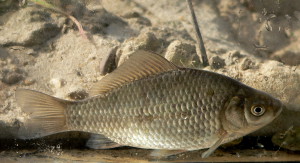 Within its vast areal, silver Prussian carps form two subspecies – the typical silver carp of China, and the common silver carp dwelling in the catchment of Amur and westward – Siberia, the Aral Sea basin and in Europe. In the Pskov-PeipsiLake it is relatively rare. In contrast to crucian, the silver carp is more attached to big lakes, and is found in big rivers. It grows faster as a rule, and reaches up to 45 cm and weighs over 1 kilo. A great share of diet is phyto- and zooplankton. Females mature at 3-4 years of age. The fertility is 160-400 thousand eggs. Silver carps display an outstanding gender correlation. There are populaces where males are either absent or very few among numerous females. Females of such unisex populaces propagate using males of other ecologically related fish species (crucian, tench or carp). The fry turns out uniformly female with no deviations from mother species. This is due to the special developmental mechanism, where a sperm entering the egg does not inseminate it, but merely stimulates its further development; yet this is not parthenogenesis, since the egg does not develop and dies without the sperm.
Within its vast areal, silver Prussian carps form two subspecies – the typical silver carp of China, and the common silver carp dwelling in the catchment of Amur and westward – Siberia, the Aral Sea basin and in Europe. In the Pskov-PeipsiLake it is relatively rare. In contrast to crucian, the silver carp is more attached to big lakes, and is found in big rivers. It grows faster as a rule, and reaches up to 45 cm and weighs over 1 kilo. A great share of diet is phyto- and zooplankton. Females mature at 3-4 years of age. The fertility is 160-400 thousand eggs. Silver carps display an outstanding gender correlation. There are populaces where males are either absent or very few among numerous females. Females of such unisex populaces propagate using males of other ecologically related fish species (crucian, tench or carp). The fry turns out uniformly female with no deviations from mother species. This is due to the special developmental mechanism, where a sperm entering the egg does not inseminate it, but merely stimulates its further development; yet this is not parthenogenesis, since the egg does not develop and dies without the sperm.
Resulting from prolonged selection and further hybridization, as well as variations in conditions, in China, Korea and Japan several hundred breeds – the so-called goldfish – of silver carps were developed.
/ * The photos at lake.peipsi.org are cross-posted from commons.wikimedia.org and are used for familiarization purposes only. No commercial use of the photos is allowed. For more information about to use the photos see the originals on commons.wikimedia.org. /


